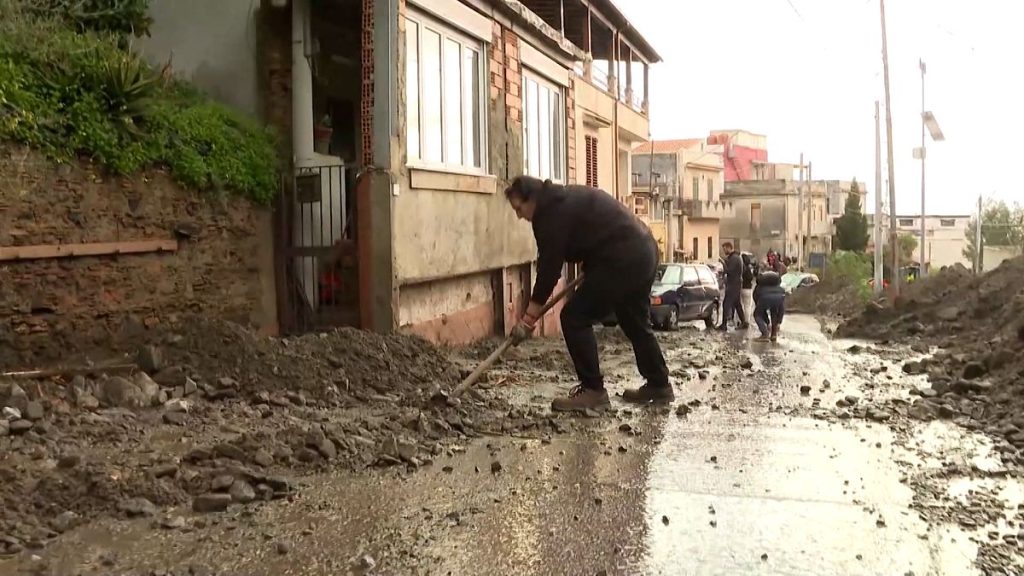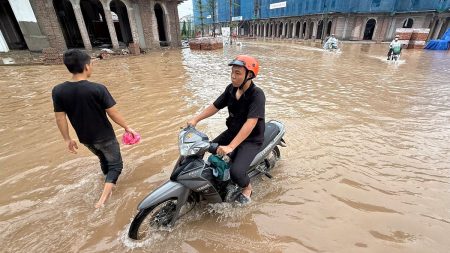The picturesque village of Zafferia, nestled in the heart of northern Sicily, Italy, has become the unfortunate epicenter of a devastating flood disaster. Torrential rains unleashed a deluge upon the region, transforming the once-charming streets into a morass of mud and debris. The relentless downpour overwhelmed the local infrastructure, causing rivers to swell beyond their banks and triggering landslides that scarred the surrounding landscape. Zafferia, bearing the brunt of nature’s fury, now finds itself at the heart of a massive clean-up operation, a testament to the resilience of its community and the dedication of emergency responders. Firefighters, rescue workers, and volunteers have descended upon the village, their efforts focused on clearing the thick layers of mud that have engulfed homes and businesses, and on securing the area against further damage. This arduous task involves removing debris, pumping out floodwaters, and shoring up weakened structures, all while contending with the emotional toll of the disaster.
The floodwaters, in their relentless advance, spared no corner of Zafferia, inundating homes, shops, and public spaces alike. The once-familiar landmarks of the village now stand as somber reminders of the destructive power of nature. Muddy streaks stain the walls of buildings, marking the high-water line of the deluge. Furniture and personal belongings, once treasured possessions, lie scattered and ruined in the streets. The scent of damp earth and decaying vegetation hangs heavy in the air, a poignant reminder of the devastation that has befallen this community. As rescue workers continue their efforts, the scale of the damage becomes increasingly apparent, revealing a village grappling with the aftermath of a natural disaster that has irrevocably altered its landscape.
Beyond the immediate impact on Zafferia, the surrounding towns and villages have also borne the brunt of the floods and subsequent landslides. The neighboring communities of Mili, Altolia, Cumia, and Ponte Schiavo, all nestled within the mountainous terrain of northern Sicily, have experienced significant disruption and damage. Landslides, triggered by the saturated earth, have carved deep scars into the hillsides, threatening homes and infrastructure. Roads have been blocked by fallen trees and debris, isolating communities and hampering rescue efforts. The widespread nature of the disaster underscores the vulnerability of the region to extreme weather events and the critical need for coordinated emergency response.
Amidst the devastation and despair, stories of heroism and resilience have emerged. One dramatic incident involved the rescue of four motorists trapped in an underground train overtaken by floodwaters. As the water levels rose rapidly, the passengers found themselves in a perilous situation, their escape route cut off by the surging torrent. Emergency services, responding swiftly to the crisis, launched a daring rescue operation, navigating the treacherous conditions to reach the trapped individuals. Their combined efforts and unwavering determination resulted in the safe extraction of all four passengers, a testament to the bravery and skill of the rescue teams.
The clean-up operation in Zafferia and the surrounding areas is expected to be a long and arduous process. The sheer volume of mud and debris, coupled with the damage to infrastructure, presents a formidable challenge. Heavy machinery is being deployed to remove the mud and debris, while engineers and construction crews work to assess the structural integrity of buildings and bridges. The restoration of essential services, such as water and electricity, is a top priority, as is the provision of temporary housing for those displaced by the floods. The recovery effort will require a concerted and sustained effort from local authorities, aid organizations, and the community itself.
The flood disaster in northern Sicily serves as a stark reminder of the increasing frequency and intensity of extreme weather events. As climate change continues to alter weather patterns, communities around the world are facing similar challenges. The recovery from this disaster will require not only immediate relief efforts but also long-term strategies to mitigate the risks of future floods and landslides. This includes investing in resilient infrastructure, improving early warning systems, and implementing sustainable land management practices. The lessons learned from this tragedy will be crucial in shaping future disaster preparedness and response efforts, both in Sicily and globally.














